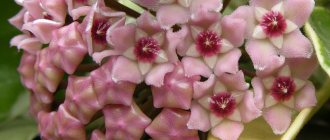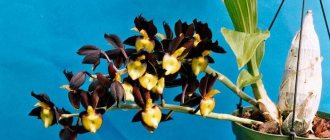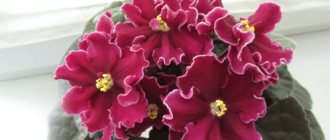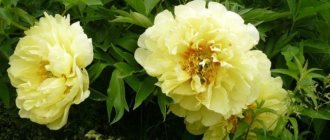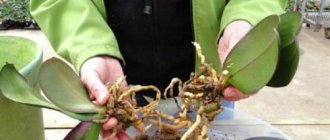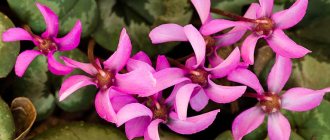The orchid that will be discussed in this article is truly a noble species, and it has no equal. Experienced gardeners are proud to have this specimen in their collection, not only because caring for the plant requires certain measures, but also because it is difficult to acquire.
Wild Cat - got its name for the special color and velvety structure of the petals.
The wild cat is a hybrid. This is Doritenopsis - a variety obtained from crossing the Phalaenopsis pleasant and Doritis most beautiful orchids.
Features of the plant and photo
Wild Cat blooms twice a year. The plant can produce a peduncle up to 60 cm long. The flowers are large (about 10 cm in diameter).
Petals and sepals are white or yellow with cherry-purple spots, the lip is slightly brighter with yellow streaks. Inflorescences are racemose, apical. The top of the peduncle gradually grows, forming more and more new flower buds, which bloom one after another.
Description of the orchid
The flower got its name because of its striking resemblance during the flowering period to a flock of butterflies. Phalaenopsis (translated from Greek phalani - moth, opsis - likeness).
The orchid is characterized by a monopodial growth form, that is, it has a single growth point.
In a normal flower growing without any pathologies, the shoot simultaneously has 4-6 fleshy, shiny dark green leaves. They grow alternately, with the upper ones being larger than the lower ones.
There are 4 standards:
- Mini orchids. The height of the plant together with the peduncle does not exceed 20 cm, the length of the leaf does not exceed 10 cm, the diameter of the flowers is 2-4 cm (examples: Hummingbird, Pink Girl and Philadelphia);
- Midi. Grows up to 40-55 cm, leaves up to 20 cm, flower diameter 4-7 cm (examples: Jena, Amabilis, Hieroglyphic);
- Ordinary. Reaches from 60 to 75 cm in height, leaves about 30 cm, flowers - 7-9 cm (examples: Stellenbosch and Cleopatra);
- Royal orchids - reach 80 cm, and some even one meter, leaves more than 30 cm, flowers - 12-15 cm in diameter (examples: Pirate Picoti, Aphrodite, Cascade).
For compact flowers, choose a pot about 7-10 cm in diameter, for the rest - about 12-15 cm.
Flower shape
The flower vaguely resembles a butterfly. On long branched peduncles there are 3 sepals, called sepals, and 3 petals.
Two side petals (petals) are larger, wider and flatter, the third is located in the core, it is smaller in size and forms a “lip”, a convenient platform for pollinating insects on which nectar is collected.
Difference from other species
As already mentioned, this species is notable for its characteristic “wild” coloring and velvety flower petals .
In addition, the Wild Cat is a hybrid and a significant difference from other species is its care features. The flower loves humidity: moist soil, moist air.
It is worth considering that you should not overwater the plant and over-humidify the air at low room temperatures. The optimal air temperature is 23 degrees, but even at a temperature of 10 degrees the plant feels comfortable. The main thing is that at low temperatures the room is not too damp.
Growing problems
Problems during cultivation usually lie in inadequate care. The main thing is to find and eliminate the problematic cause in time. Possible problems can be described as follows:
- yellowing and lethargy of leaves - overwatering or insufficient watering, lack of lighting, sunburn, low (critical) temperature;
- rotting of the root system - excessive watering;
- wilting of the leaf mass - low temperature or dry air;
- brown color and drying of roots - excess fertilizer;
- does not bloom for a long time - there is no difference between day and night temperatures.
Bloom
The wild cat blooms twice a year for 2-3 months .
This species practically does not hibernate, so the development process is constant and active. Gardeners are very fond of the Wild Cat for these properties. If flowering does not occur within a year, then this is a reason to be wary and take measures to restore the plant.
Wild cat is a whimsical flower , but if you follow all the rules of care, it will delight you with its flowering all year round:
- sufficient lighting,
- proper watering,
- absence of stress (transplantation, draft, waterlogging),
- no unnecessary movements of the flower pot.
Cost, where to find?
Wild cat is a rare variety . It is difficult to get and when buying such a plant you need to make sure that the species is correct. Therefore, it is best to take a flower with a blossoming bud.
Average cost of an adult plant: 1600-2000 rubles.
You can find Wild Cat in specialized flower shops or online (that is, buy it second-hand). In both the first and second cases, you must make sure that the roots of the plant do not have white coating or rot, the trunk is hard, and the leaves are fleshy and bright green. The flowers are large with a characteristic color and a light glossy coating (this is wax, a characteristic feature of the flowering of healthy phalaenopsis).
You can purchase a non-flowering plant in specialized stores. The disadvantage of such a purchase is that you will not be able to find out exactly what variety the seller sold you. And the advantage of such an acquisition is that it is much cheaper than buying a flowering plant.
The average price of a plant without arrows and peduncles: 600 – 1000 rubles.
Reproduction
Before talking about propagation methods, it is worth touching on the topic of selecting pots and soil, as well as care in the first half of the year of the plant’s life.
Choosing a pot
Orchids are aerial root plants. Therefore, the roots of this plant need a lot of oxygen, as well as lighting . Therefore, it is necessary to choose transparent or translucent pots for the plant.
There are also special pots for orchids. If you still want to plant a plant in a beautiful pot, then it is better to choose a non-porous, flat pot or flowerpot. For such pots, you can purchase a special “crown” so that the plant stands firmly and feels good.
Soil selection
For an orchid, you can buy a ready-made substrate in the store or make it yourself from pine bark (boiled and crushed), sphagnum moss and peat. also put moss on top of the Wild Cat's roots , which is sold in specialized stores. Moss retains moisture well and does not allow the plant to dry out.
Reproduction methods
Phalaenopsis reproduce at home in 3 ways.
Children
They can only appear at very high temperatures, so this must be taken into account. If they are absent for a long time, then the plant can be stimulated.
- To do this, you need to make an incision on the kidney located closest to the main arrow. It is best to make an incision with a very sharp object.
- Using tweezers, remove the cut scales.
- Treat the opened bud immediately with a stimulant.
Literally a month after this, a baby will appear at the place of the cut. There is no need to cut it off immediately after it appears. You need to wait until the roots appear, as well as at least two leaves. Only after this can it be carefully cut and transplanted into a separate pot, where the soil has been prepared in advance.
Peduncles
- After flowering, cut off the living peduncle and divide it into parts, each of which should have at least 1 dormant bud.
- Germinate them in a special greenhouse with moss at a temperature of 25-27 ℃.
- Plant in a permanent pot when a root of at least 5 cm appears.
Dividing the bush
- Prepare containers for transplantation in advance.
- Carefully remove the plant from the pot without damaging the roots.
- Use your fingers to carefully separate the plant in those places where it is more comfortable to do so. If the roots are too close to each other somewhere, then it is better not to separate them. The easiest way to make division is to start from the outer leaves and their root component.
- If bad roots are found, they should be carefully cut off with pruners or a very sharp knife.
- Carefully treat all places where there were cuts or damage to the roots with a special solution.
With this method of propagation, the plant will not bloom for 2-3 years.
The first months after rooting
If you take good care of the plant in the first month and it takes root well, then you can do a light feeding and repeat the light feeding every 2-3 months until the plant grows and gets stronger, and subsequently produces gorgeous flowers.
Soil requirements
Planting an orchid requires special soil. Experts recommend purchasing it in a store. The substrate usually consists of steamed pine bark, the size of the pieces varies from manufacturer to manufacturer. Sometimes charcoal and sphagnum moss are added to the soil. If you wish, you can do this yourself. The presence of moss in a pot is a purely individual matter. Some gardeners practice its use, while others do not. In addition, the substrate may contain coconut chips and fern root.
High-quality soil should have the following properties:
- Its structure must be dense to provide support for the plant.
- High air and water permeability.
- Ability to retain nutrients.
After purchasing an orchid, it needs to create the right conditions. The plant must adapt to your home. He needs to choose a well-lit place with diffused light. Healthy plants are not replanted. Orchids can be grown in a purchased pot for several years.
Plant care
First, it’s worth touching on the topic of caring for a plant after purchasing it. A wild cat needs to settle into a new place: get used to the temperature and light. It is necessary to immediately find a place for the plant where it will live and check whether the roots are dry.
If the roots are dry, then it is best to soak them for literally 3-5 minutes, then place the flower and do not touch it for a week. After this, gradually accustom it to watering.
Temperature
For a normal life, a flower needs to maintain a temperature: 25-30 degrees in summer, 20-23 degrees in winter . After the full flowering cycle, the plant can be moved to the shade for 2 weeks, where the temperature is kept around 10-15 degrees, while it should not be over-watered either by watering or by general air humidity. This procedure is not necessary. It will help put the orchid into a light hibernation and restore strength after flowering, which will result in more luxuriant flowering in the future.
Lighting
A wild cat loves bright lighting; daylight hours at any time of the year should average 12 hours. It is worth remembering that direct sunlight is extremely harmful to leaves. Therefore, it is worth placing the plant in a place of diffused light. You can also light plants artificially. For this purpose, optimal LED and fluorescent lamps are used. Completely artificial lighting is not advisable; the plant should receive at least some sunlight.
Watering
Orchid loves moisture. On average, watering should be done 2 times a week , but avoid overwatering. To accurately determine that the roots are dry enough for the next watering, you can look at them through a transparent pot or crown.
If the roots are bright green, then the flower still has enough moisture; if it is light green, then it needs to be watered. Also, the plant should not be watered at night, because it is sleeping, and under no circumstances should you water it in the middle - this will lead to rapid rotting.
There is also a good practice among gardeners: do not water the orchid, but “soak” it in a basin . The principle is simple:
- Pour water at room temperature into a basin so that the water does not touch the leaves and upper roots where the stem begins (optimally - 2/3 of the height of the pot).
- Leave the flower for 10-15 minutes.
- Now you can not water the plant for a whole week and not worry that it is not saturated enough.
Top dressing
Flower shops have a huge selection of fertilizers for orchids. You can also find various antiseptics for roots, healing and stimulating herbal preparations.
The main rule for feeding orchids is that if the plant is blooming, it should not be fed. The rest of the time, fertilizing can be done once every 2-3 months.
Trimming
For the Wild Cat, trimming the peduncle is the last thing. The arrow is capable of producing new shoots and flowers even after a year. The arrow should only be cut if it has dried out . This must be done with a sharp knife or pruning shears 2 cm above the first dormant shoot.
Transfer
Phalaenopsis should be replanted only when absolutely necessary (root disease) or once every 2 years. And then, this needs to be done only because the land is depleted during this time and needs to be renewed.
- The old pot is cut so as not to damage the delicate and very brittle roots.
- Rotten and damaged roots are cut off.
- The cut areas are treated with crushed activated carbon or cinnamon powder.
- Drainage 2 cm thick from inert components is poured onto the bottom.
- Then the plant is carefully lowered into a container, which, sequentially, filling all the voids and lightly compacting, is filled with bark - 1.5-2 cm; Pieces of charcoal are added to the bark as a sorbent.
Care during the flowering period
Care during the flowering period comes down to regular watering and sufficient light . The only thing that should be excluded is fertilizing and replanting.
What to do if the buds don't appear?
First you need to ask yourself: how old is the plant?
An orchid does not bloom until three years after it has fully matured.
If the plant is old enough, then there is a possibility that the plant has received insufficient care or is sick. Review all care points, check the plant for diseases. If everything is fine with the plant, then you should just wait. Phalaenopsis can sometimes be very whimsical and they need a little time to show all their beauty.
Diseases and pests
A wild cat, like all orchids, rarely succumbs to various diseases with proper care. It is also easily treated with simple medications. This variety is mainly affected by fusarium and gray rot . These diseases are treated with specialized medications and removal of the affected parts. Common pests include thrips and spider mites. They are also removed with special drugs.
The best method to protect a plant from all diseases and parasites is to follow proper care and take timely treatment measures.
In general, the Wild Cat orchid is a fairly easy-to-care plant that is ready to delight its owner with bright and long flowering.
The history of the creation of this variety of phalaenopsis
The founders of the pedigree of this type of orchid are considered to be: the parent of the seed - Phalaenopsis Fantastic Mirage Tin-Fan Ho Ho, the parent of the pollen - Phalaenopsis Jiuhbao Red Rose Jiu Bao Biotech.
The ancestors of the Wild Cat grew in the mountain forests of the Philippines and on the Australian plains. Officially, this hybrid, obtained from crossing Phalaenopsis pleasant and Doritis most beautiful, was registered in 2008.

